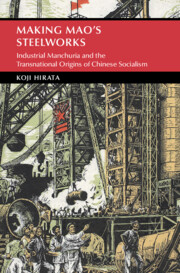Book contents
- Making Mao’s Steelworks
- Cambridge Studies in the History of the People’s Republic of China
- Making Mao’s Steelworks
- Copyright page
- Contents
- Figures
- Tables
- Preface
- Abbreviations
- Introduction
- Part I Empire, War, and the Global Crisis of Capitalism, 1915–1948
- Part II Socialist Industrialization as a Hybrid System, 1948–1957
- Part III Socialisms with Chinese Characteristics, 1957–2000
- 7 The Three Lives of the Angang Constitution
- 8 The Socialist Rust Belt in the Market Economy
- Conclusion
- Acknowledgments
- Appendix A Note on Primary Sources
- Bibliography
- Index
8 - The Socialist Rust Belt in the Market Economy
from Part III - Socialisms with Chinese Characteristics, 1957–2000
Published online by Cambridge University Press: 19 December 2024
- Making Mao’s Steelworks
- Cambridge Studies in the History of the People’s Republic of China
- Making Mao’s Steelworks
- Copyright page
- Contents
- Figures
- Tables
- Preface
- Abbreviations
- Introduction
- Part I Empire, War, and the Global Crisis of Capitalism, 1915–1948
- Part II Socialist Industrialization as a Hybrid System, 1948–1957
- Part III Socialisms with Chinese Characteristics, 1957–2000
- 7 The Three Lives of the Angang Constitution
- 8 The Socialist Rust Belt in the Market Economy
- Conclusion
- Acknowledgments
- Appendix A Note on Primary Sources
- Bibliography
- Index
Summary
This chapter explores Angang and Northeast China during the economic reforms following Mao’s death in 1976. As the People’s Republic of China’s (PRC) developmental strategy shifted its focus to export-oriented light industry, regions with a greater presence of heavy industry such as Northeast China fared worse than light industry regions such as East China. Despite a series of state-owned enterprise (SOE) reforms including privatization, the PRC further integrated larger SOEs such as Angang into the party-state bureaucracy. The final echo of the Maoist era emerged in the form of SOE workers protesting for job security and social welfare benefits by appropriating the socialist discourse of the state. As China moved away from socialist industrialization, the legacies of this period in Northeast China transformed the region into a rust belt filled with ageing, unprofitable SOEs in heavy industry.
- Type
- Chapter
- Information
- Making Mao's SteelworksIndustrial Manchuria and the Transnational Origins of Chinese Socialism, pp. 265 - 293Publisher: Cambridge University PressPrint publication year: 2024

